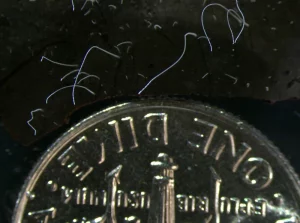
Some bacteria are visible to the naked eye and as long as human eyelashes! The recently discovered centimeter long bacteria, now called Thiomargarita magnifica, live on sunken leaves in Caribbean mangrove swamps.
I don't know whether to shudder or to be excited by the amazing large size of the bacteria. These bacteria are the largest ever found, and are about 5000 times the size of most bacteria (which can only be seen under a microscope).
In fact, Dr. Levin of Washington Univ. pointed out that these bacteria can't even rightly be called microbes, because microbes are by definition microscopic! (She wrote a commentary accompanying the research report in the journal Science). A number of things are amazing about the huge bacteria!
Excerpts from NPR: Think all bacteria are microscopic? Tell that to these centimeter-long monsters
Bacteria typically live out their teeny-tiny lives in the microscopic realm, but now scientists have found a gargantuan one the size and shape of a human eyelash.
The new find is "by far the largest bacteria known to date," says Jean-Marie Volland of Lawrence Berkeley National Laboratory and the Laboratory for Research in Complex Systems. "These bacteria are about 5,000 times larger than most bacteria."
"To put things into perspective," he added, "it is the equivalent for us humans to encounter another human who would be as tall as Mount Everest."
The roughly 1 centimeter behemoth somehow attaches itself to sunken leaves in Caribbean mangrove swamps, according to a report in the journal Science.
The scientist who initially collected the thin white filaments had no idea that he'd discovered a new kind of bacteria visible to the naked eye. But a lab examination showed that they didn't have key features of plant or animal cells, and a genetic analysis soon revealed their true nature. They're related to other bacteria that also make a living off of sulfur and grow large — but not this large.
Now called Thiomargarita magnifica, these bacteria haven't yet been grown in the lab, so much about their lifestyle remains mysterious — including what advantage they get in their underwater environment by growing to such a stupendous size.
In addition to challenging old ideas about the maximum possible size, each of these bacteria organizes its innards in an unusually advanced way.
What's more, while most bacteria reproduce by dividing into two identical cells, these long, filament-like creatures seem to reproduce by budding off one small piece at the tip that can then float away and go on to create a whole new being.
